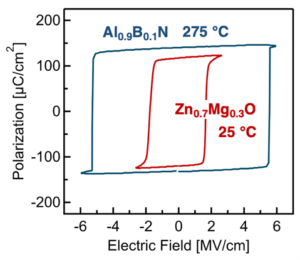VINSE Colloquium Series: “Tetrahedral ferroelectrics based on cation-substituted ZnO and AlN” Dr. Jon-Paul Maria, Pennsylvania State University 4/6/22
April 6, 2022
Dr. Jon-Paul Maria
Professor of Materials Science and Engineering
Pennsylvania State University
“Tetrahedral ferroelectrics based on cation-substituted ZnO and AlN”
4:10 PM, 134 Featheringill Hall
Refreshments served at 3:45 PM
Abstract. In the past two years, the demonstration of ferroelectricity in wurtzite-based crystals introduced exciting opportunities to explore and discover new structure-property relationships in novel formulation spaces, and to investigate new integration and device implementations given new process compatibilities. The seminal discovery of ferroelectric Al1-xScxN by Fichtner et al.1 initiated this excitement and was followed by comparable observations of polarization reversal in the structurally similar Al1-xBxN2 and the Zn1-xMgxO3 systems.
In this presentation the structure-process-property relationships in the B-substituted AlN and Mg-substituted ZnO wurtzite systems will be demonstrated. The B-substituted materials exhibit square hysteresis loops with polarization values between 150 µC/cm2 and 120 µC/cm2 when boron concentrations range between 2% and 15% respectively. Coercive field values fall with additional boron, from 5.5MV/cm to about 5 MV/cm at B saturation. Bandgap values are approximately 5 eV or above in all cases. Material can be prepared between 100 °C and 350 °C with very little difference in electrical properties. W bottom and top electrodes are used in all cases. Capacitors can be prepared down to 50 nm thick before leakage current becomes problematic during low frequency hysteresis measurements. First principles calculations that rationalize the unit cell volume, bond angle distribution, and remanent polarization will be presented.
Comparable results are found in the Zn1-xMgxO system. Between 25% and 35% Mg substitution, square hysteresis loops with remanent polarization values above 100 µC/cm2 are readily achieved. Transmission measurements show bandgap values between 4.0 eV and 4.2 eV in this range. In comparison to AlBN, coercive field values for ZMO are as low as 1.7 MV/cm. As is the case with AlBN and AlScN, sustaining high insulation resistance to arbitrarily low thickness is challenging, the current thinness limit for low-leakage switching is ~ 125 nm. SHG analysis will also be presented for the ZMO system – preliminary measurements suggest values comparable to ferroelectric niobates.
In addition to a discussion of properties and preferred synthesis routes, we will discuss the limitations to property engineering and scaling, including proposals based on aliovalent doping, improved epitaxy, and deposition energetics to overcome them.
1Fichtner et al., “AlScN: A III-V semiconductor based ferroelectric,” J. Appl. Phys., 114103, (2019). 2Hayden et al, “Ferroelectricity in Boron-Substituted Aluminum Nitride Thin Films,” Phys. Rev. Mat., AN 044412, April, 2021. 3Ferri et al, “Ferroelectricity in Magnesium-Substituted Zinc Oxide thin films,” in press, JAP 2021.
Bio. Jon-Paul Maria is a Professor of Materials Science and Engineering at The Pennsylvania State University. Prior to joining Penn State, Jon-Paul was a faculty member at North Carolina State University where he spent 15 years serving in the Materials Science and Engineering department. Jon-Paul received his BS., MS, and Ph.D. degrees from Penn State in Ceramic Science. Jon-Paul’s research group pursues new materials discovery, property engineering, advances in synthesis science, and new integration strategies to merge diverse materials. Laboratory activities of interest include physical vapor deposition, ceramic synthesis by powder processing, structural characterization by diffraction, and microstructure measurement using scanning probe and scanning electron microscopy. The Maria Group members currently pursue research in the areas of ferroelectric thin films, high permittivity materials, novel semiconductor contacts, oxide epitaxy, infra-red plasmonic materials and entropy engineered/stabilized crystals. With assistance from many collaborators, The Maria group published over 250 manuscripts dealing with structure-property-processing relationships in electronic materials. In 2016 Jon-Paul co-founded Third Floor Materials, a startup company that endeavors to develop novel IR sensor materials and technologies.

